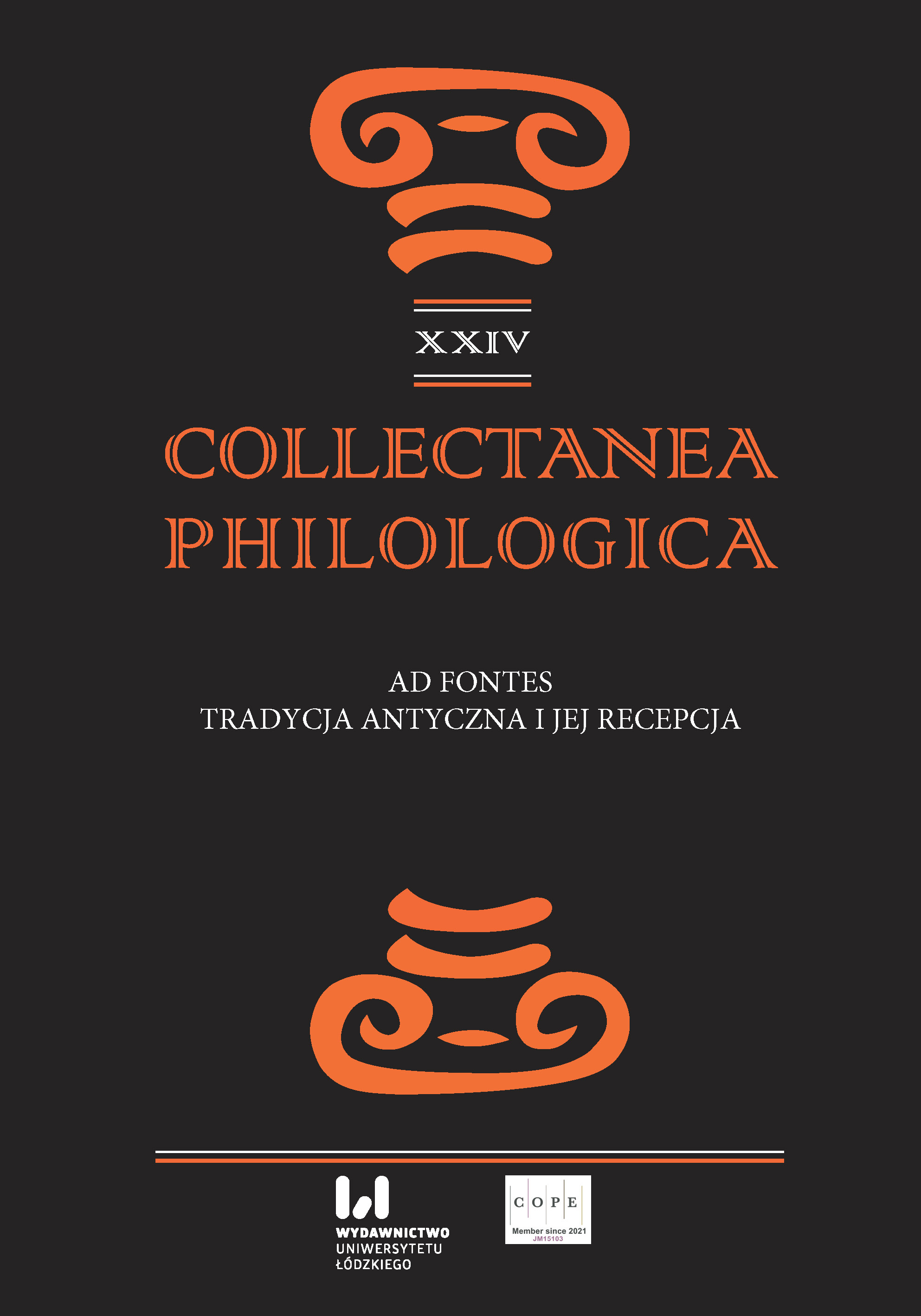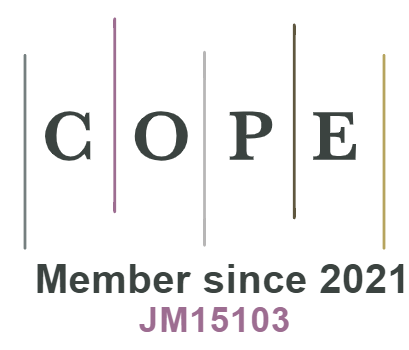Redness as Perceived through the Eyes of the Romans
DOI:
https://doi.org/10.18778/1733-0319.24.05Keywords:
ancient Rome, colours, red, terminologyAbstract
The article is an attempt to revise the long-established belief in the alabaster-white exterior shape of Roman antiquity, which in fact turns out to be full of colours that bring life to its image. The authors implement this intention by indicating how intensely the colour red was present in the reality described by classical Latin authors – contrary to the accusation that one of the participants of the discussion on this subject in Aulus Gellius’ Attic Nights (Gell. Noc. Att. 2.26) makes of the alleged poverty regarding various shades of red in Latin terminology. The material presented contradicts the opinion expressed in Gellius’ text, and at the same time makes us realise how colourful and lively the world that emerges from the literary works of the classical Roman period was. In comparison with it, the reality witnessed by the literature of the Christian era – this parallel is what the authors of the article focus on, concluding their deliberations – in which red becomes almost exclusively a sign of shame, turns out to be ascetically sterile and depressingly colourless.
References
Apuleio. (1988). Metamorfosi (L’asino d’oro). A cura di M. Cavalli. Milano: Mondadori.
Google Scholar
Arnobius. (1953). Adversus nationes libri VII. Ed. C. Marchesi. Aug. Taurinorum: Io. Bapt. Paraviae et Sociorum.
Google Scholar
Augustinus Hipponensis, A. (1981). De civitate Dei libri XXII. Ed. B. Dombart et A. Kalb. Stutgardiae: B. G. Teubneri.
Google Scholar
Carus Lucretius Titus. (1982). De rerum natura libri sex. Ed. J. Martin. Leipzig: Teubner.
Google Scholar
Catulle. (2015). Poésies. Éd. et trad. par G. Lafaye. Paris: Les Belles Lettres.
Google Scholar
Celsus, A.C. (1831). On Medicine. Vol. I‒II. Ed. A. Lee. London: Cox.
Google Scholar
Cicero, M.T. (1922). Orationes. Clark, A.C. Oxford: Oxford University Press; Oxford Classical Texts.
Google Scholar
Cicero, M.T. (1933). Cicero. De Natura Deorum. Plasberg, O. Leipzig: Teubner.
Google Scholar
DOI: https://doi.org/10.4159/DLCL.marcus_tullius_cicero-de_natura_deorum.1933
Cicero, M.T. (1961). Ciceronis Epistulae. Vol. II. Rec. D.R. Shackleton Bailey. Oxford: Oxford University Press. Oxford Classical Texts.
Google Scholar
Cicero, M.T. (1978). Lucullus. In: A. Russo (ed.) Scettici antichi. Torino: UTET.
Google Scholar
Cicero, M.T. (1987). Scripta quae manserunt omnia. De Divinatione, De Fato, Timaeus. Plasberg, O., Ax, W. Leipzig: Teubner https://doi.org/10.1515/9783110952544
Google Scholar
DOI: https://doi.org/10.1515/9783110952544.154
Cicéron, M.T. (2002). Correspondance. T. VII. Éd. et trad. par J. Beaujeu. Paris: Les Belles Lettres.
Google Scholar
Columella, L.I.M. (1794). De re rustica lib. XII Et Librum De Arboribus. Ed. J.G. Schneider. Lipsiae: Fritsch.
Google Scholar
Columelle. (2002). De l’agriculture. L. X. Éd. et trad. par E. de Saint-Denis. Paris: Les Belles Lettres.
Google Scholar
Columelle. (2002). De l’agriculture. L. XII. Éd. et trad. par J. André. Paris: Les Belles Lettres.
Google Scholar
Diomedes. (1857–1870). Ars Grammatica. In: H. Keil (ed.) Grammatici Latini. Lipsiae: Teubner.
Google Scholar
Flaccus, Q.H. (1970). Q. Horatii Flacci Opera. Ed. F. Klinger. Leipzig: Teubner.
Google Scholar
Flaccus, V. (1970). Valeri Flacci Argonauticon. Rec. E. Courtney. Leipzig: Teubner.
Google Scholar
Gellio Aulo. (2017). Le notti attiche. T. I–II. A cura di G. Bernardi-Perini. Torino: UTET.
Google Scholar
Hygin. (2012). Fables. Éd. et trad. par J.-Y. Boriaud. Paris: Les Belles Lettres.
Google Scholar
Iuvenalis, D.I., Persius, A.F. (2004). Juvenal and Persius. Ed. S.M. Braund. London: Harvard University Press.
Google Scholar
Largus Scribonius. (1529). De compositione medicamentorum liber. Ed. J. Winter, J. Ruel. Basilea: Cratandrus.
Google Scholar
Lucain. (1836). La guerre civile (La Pharsale). T. II (l. VI–X). Éd par C.L.F. Panckoucke. Paris: Les Belles Lettres.
Google Scholar
Martial. (1993). Epigrams. Vol. I. Transl. R. Shackleton, D. Bailey. Cambridge: Harvard University Press. Loeb Classical Library.
Google Scholar
DOI: https://doi.org/10.4159/DLCL.martial-epigrams.1993
Martial. (1993). Epigrammes II. Éd et trad. par H. J. Izaac. Paris: Les Belles Lettres.
Google Scholar
Ovide. (1960). L’Art d’aimer. Trad. par H. Bornecque. Paris: Les Belles Lettres.
Google Scholar
Ovide. (1961). Les Remèdes à l’amour, Les produits de beauté pour le visage de la femme. Trad. Par H. Bornecque. Paris: Les Belles Lettres.
Google Scholar
Ovide. (1968). Tristes. Trad. par J. André. Paris: Les Belles Lettres.
Google Scholar
Ovide. (1992‒1993). Les Fastes. T. 1‒2. Trad. et com. par R. Schilling. Paris: Les Belles Lettres.
Google Scholar
Ovidius, P.N. (1985). Metamorphoses. Ed. W. S. Anderson. Leipzig: Teubner.
Google Scholar
Pétrone. (2001). Satiricon. Éd et trad. par O. Sers. Paris: Les Belles Lettres.
Google Scholar
Plaute. (1932). Comédies. T. I. Éd et trad. par A. Ernout. Paris: Les Belles Lettres.
Google Scholar
Plaute. (2002). Comédies. T. II, VI. Éd et trad. par A. Ernout. Paris: Les Belles Lettres.
Google Scholar
Plinio il Vecchio (Gaio Plinio Secondo). (1982–1988). Storia Naturale. Vol. 1–5. A cura di G.B. Conte. Torino: Einaudi.
Google Scholar
Properce. (1961). Les Élégies. Trad. par D. Paganelli. Paris: Les Belles Lettres.
Google Scholar
Pseudo-César. (1997). Guerre d’Afrique. Éd. et trad. par A. Bouvet. Paris: Les Belles Lettres.
Google Scholar
Sénèque. (1912). Questions naturelles. T. II (l. IV–VII). Trad. par P. Oltramare. Paris: Les Belles Lettres.
Google Scholar
Sénèque. (2013). Tragédies. T. II. Éd. et trad. par F.-R. Chaumartin. Paris: Les Belles Lettres.
Google Scholar
Stace. (2003). Silves. T. I–II. Éd. par F. Frère. Paris: Les Belles Lettres.
Google Scholar
Stace. (2003). Thébaïde. T. I–III. Éd. et trad. par R. Lesueur. Paris: Les Belles Lettres.
Google Scholar
Suétone. (1931). Vie des douze Césars. T. II. Éd. et trad. par H. Ailloud. Paris: Les Belles Lettres.
Google Scholar
Suétone. (2011). Vie des douze Césars. T. III. Éd. et trad. par H. Ailloud. Paris: Les Belles Lettres.
Google Scholar
Tacite. (2002). Histoires. T. II: l. II–III. Éd. et trad. par J. Hellegouarc’h. Paris: Les Belles Lettres.
Google Scholar
Tacite. (2013). Annales. T. I: l. I–III. Éd et trad. par P. Wuilleumier. Paris: Les Belles Lettres.
Google Scholar
Térence. (2002). Comédies. T. II–III. Éd. et trad. par J. Marouzeau. Paris: Les Belles Lettres.
Google Scholar
Tertullien. (1942). Quinti Septimi Tertuliani opera. Ed. E. Kroymann. Lipsiae: AkademischeVerlagsgesellschaft.
Google Scholar
Tibulle. (2002). Élégies. Éd. et trad. par M. Ponchont. Paris: Les Belles Lettres.
Google Scholar
Tite-Live. (2002). Histoire romaine. T. XXI: l. XXXI. Éd et trad. par A. Hus. Paris: Les Belles Lettres.
Google Scholar
Tite-Live. (2002). Histoire romaine. T. XXVI: l. XXXVI. Éd et trad. par A. Manuélian. Paris: Les Belles Lettres.
Google Scholar
Tite-Live. (2003). Histoire romaine. T. II: l. II. Éd par J. Bayet. Paris: Les Belles Lettres.
Google Scholar
Tite-Live. (2012). Histoire romaine. T. I: l. I. Éd par J. Bayet. Paris: Les Belles Lettres.
Google Scholar
Varro. (1938). On the Latin Language. Vol. I: b. 5–7. Transl. by R.G. Kent. Cambridge: MA: Harvard University Press.
Google Scholar
DOI: https://doi.org/10.4159/DLCL.varro-latin_language.1938
Varro, M.T. (1985). Saturarum menippearum fragmenta. Ed. R. Astbury. Leipzig: Teubner.
Google Scholar
Varron. (1997–2002). Économie rurale. L. II–III. Trad. par Ch. Guiraud. Paris: Les Belles Lettres.
Google Scholar
Varron. (2002). Économie rurale. L. I. Trad. par J. Heurgon. Paris: Les Belles Lettres.
Google Scholar
Virgile. (2009). Géorgiques. Trad. par E. de Saint-Denis. Paris: Les Belles Lettres.
Google Scholar
Virgile. (2014). Bucoliques. Éd. par E. de Saint-Denis. Paris: Les Belles Lettres.
Google Scholar
Virgile. (2015). L’Énéide/Aeneis. Trad. par O. Sers. Paris: Les Belles Lettres.
Google Scholar
Vitruve. (2015). De l’architecture. Éd. par P. Gros. Paris: Les Belles Lettres.
Google Scholar
André, J. (1949). Étude sur les Termes de Couleur dans la langue Latine. Paris: Librairie C. Klincksieck.
Google Scholar
Bond, S.E. (2017). “Why We Need to Start Seeing the Classical World in Color”. Hyperallergic, [online] https://hyperallergic.com/383776/why-we-need-to-start-seeing-the-classical-worldin-color/ (date of access 26 July 2020).
Google Scholar
Bradley, M. (2009). Colour and Meaning in Ancient Rome. Cambridge: Cambridge University Press.
Google Scholar
Brinkmann, V. et al. (eds.) (2017). Gods in Color: Polychromy in the Ancient World. New York: Prestel.
Google Scholar
Clarke, J.R. (1998). Imagery of Colour and Shining in Catullus, Propertius and Horace. Adelaide: University of Adelaide.
Google Scholar
Dupont, F. (2006). La vita quotidiana nella Roma repubblicana. Roma–Bari: Laterza.
Google Scholar
Edgeworth, R.J. (1979). “Does ‘purpureus’ mean ‘bright’?”. Glotta 57. 281–291.
Google Scholar
Elliott, Ch. (2008). “Purple Pasts: Color Codification in the Ancient World”. Law & Social Inquiry 33/1. 173–194 https://doi.org/10.1111/j.1747-4469.2008.00097.x
Google Scholar
DOI: https://doi.org/10.1111/j.1747-4469.2008.00097.x
Étienne, R. et F. (1990). La Grèce antique: archèologie d’une dècouverte. Paris: Gallimard.
Google Scholar
Gage, J. (1993). Color and Culture: Practice and Meaning from Antiquity to Abstraction. Berkeley: University of California Press.
Google Scholar
Götter, B. (2003). Die Farbigkeit antiker Skulptur. Munich: Glyptothek.
Google Scholar
Gryksa, E. (2018). Color armorum w literaturze rzymskiej. In: A. Kucz, P. Matusiak (eds.). Lingua coloris (T. 4. Szkice o antyku). Katowice: Wydawnictwo Uniwersytetu Śląskiego. 39–48.
Google Scholar
Hunt, A. (1996). Governance of the Consuming Passions: A History of Sumptuary Law. New York: St. Martin’s Press https://doi.org/10.1057/9780333984390
Google Scholar
DOI: https://doi.org/10.1057/9780333984390
Liverani, P., Santamaria, U. (eds.) (2014). Diversamente bianco. La policromia della scultura romana. Roma: Quasar.
Google Scholar
Moulinier-Brogi, L. (2012). Uroscopie au Moyen-Age. Lire dans un verre la nature de l’homme. Paris: Champion.
Google Scholar
Ogórka-Tabiś, A. (2018). Czy wino może być zielone? ‒ zmiany parametrów barwy wina czerwonego pod wpływem wybranych czynników chemicznych i biologicznych. In: A. Kucz, P. Matusiak (eds.). Lingua coloris (T. 4. Szkice o antyku). Katowice: Wydawnictwo Uniwersytetu Śląskiego. 143–156.
Google Scholar
Pastoureau, M. (2006). Średniowieczna gra symboli. Warszawa: Oficyna Naukowa.
Google Scholar
Pelletier-Michaud L. (2016). Évolution du sens des termes de couleur et de leur traitement poétique. L’élégie romaine et ses modèles grecs. Québec: Université Laval.
Google Scholar
Phipps, E. (2010). Cochineal Red: The Art History of a Color. New York: The Metropolitan Museum of Art, New Haven–London: Yale University Press.
Google Scholar
Piechocka-Kłos, M. (2016). „Rozważania o różnorodności kolorów i ich łacińskich oraz greckich nazwach w Nocach Attyckich (2.26) Aulusa Gelliusza”. Studia Warmińskie 53. 319–329 https://doi.org/10.31648/sw.106
Google Scholar
DOI: https://doi.org/10.31648/sw.106
Reinhold, M. (1970). History of Purple as a Status Symbol in Antiquity. Brussels: Latomus.
Google Scholar
Rzepińska, M. (1983). Historia koloru w dziejach malarstwa europejskiego. Kraków: Wydawnictwo Literackie.
Google Scholar
Segura Ramos, B. (2006). “El color de Vergilio”. Cuadernos de Filología Clásica. Estudios Latinos 26/2. 37–69.
Google Scholar
Skwara, E. (2001). Historia komedii rzymskiej. Warszawa: Prószyński i S-ka.
Google Scholar
Thomas, Ph.L. (1979). “Red and White: A Roman Color Symbol”. Rheinisches Museum für Philologie, 122. 310–316.
Google Scholar
Published
How to Cite
Issue
Section
License

This work is licensed under a Creative Commons Attribution-NonCommercial-NoDerivatives 4.0 International License.












